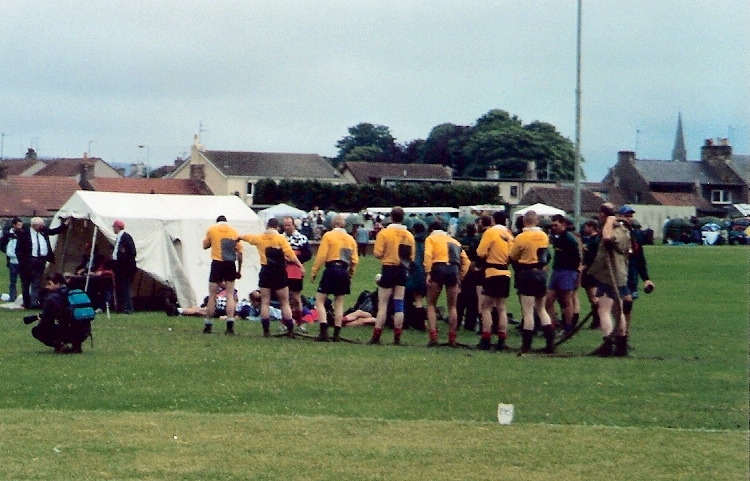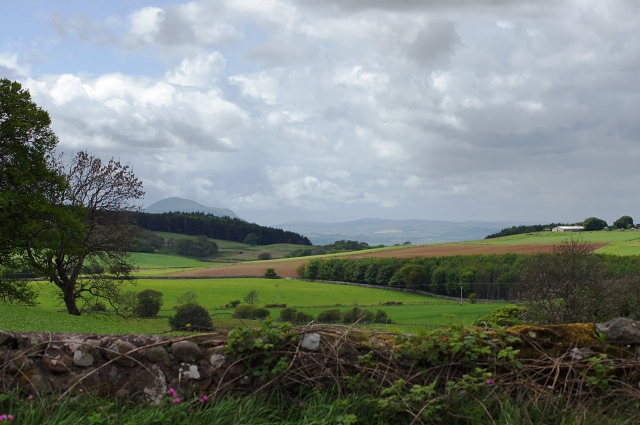
The clouds are ominous as we set off for Cupar. Thick fog obscures hilltops. It's chilly and dreary, and we hope to avoid the rain that has been forecast for the area. We leave the motorway, driving through small towns, rolling through the Ancient Kingdom of Fife.
It's so still and quiet in the countryside. I am filled with a sense of history as we travel through wide open spaces and small villages. It's easy to send myself back through the centuries, as I have so many times on this trip.
Although no decisive battles took place here in the past, this area of Scotland was embroiled in the upheavals of the war of independence, with MacDuff, the Earl of Fife, defeated by English adherents and being taken prisoner just before the Battle of Stirling. Cupar, too, was a place of some importance in the late 13th century. King Alexander III's first wife, Queen Margaret, died there in 1275.
Soon we've hit the outskirts of Cupar, passing by a low stone wall with a sign that points the way to a rugby park. The town seems almost deserted, and I'm reminded that it's Sunday and that last Sunday at this time of day I was standing atop Hadrian's Wall. I am amazed at how much I've seen in my time here and excited that there's more yet to be seen.
We've driven completely through town before we finally spy a banner strung across the road – the first indication that yes, there are festivities going on in this town today. Where? It's anyone's guess. Certainly not at the park we're looking at now, where children pump their short little legs to achieve a higher height on the swings. We sit at a welcome stop light, one of very few we've seen over the past ten days.
In a car park to our left we see a pipe band and a lot of cars with people milling about. It makes no sense. Here's the sign announcing the Games, here are people who look as if they're going to be participating, but other than a playground and a car park there's nothing here.
We've passed the entry to the car park and swing around on a side street once the light turns green. Robin lowers the window and I (feeling like a fool) find that the cat has my tongue. Robin leans across me and asks a woman where the games will be held. Back the other way, she says, inclining her head in the direction from which we've arrived – at the rugby park.
Back through town we drive, turning down the appropriate road and passing through a residential area to the rugby park. There are a lot of cars parked in a field here and we make note of goal posts to our left so we can easily find ours in this sea of other cars when we're ready to leave. Admission is £5; the majority of which goes to charity. The Cupar games have been held for the past twenty-three years and raised over £35,000.
The weather has not improved; it's gray, windy and chilly with a hint of moisture in the air, but none falling on our heads. I am thankful for my many layers as we make a circuit around the track where, later, cycle races will be held. The natives have come well prepared; many have small cabanas set up around the perimeter of the main area where teams compete at tug of war and tiny little girls compete at highland dance.

Fife is situated between the Firth of Tay and the Firth of Forth, with inland boundaries to Perth and Kinross and Clackmannanshire. By custom it is widely held to have been one of the major Pictish kingdoms, and is still commonly known as the Kingdom of Fife within Scotland.
Fife was an important royal and political center from the reign of King Malcolm III onwards, as the leaders of Scotland gradually moved southwards away from their ancient strongholds around Scone. Malcolm had his principal home in Dunfermline and his wife Margaret was the main benefactor of Dunfermline Abbey. The Abbey replaced Iona as the final resting place of Scotland's royal elite, with Robert I amongst those to be buried there.
Read more about Fife at Wikipedia.